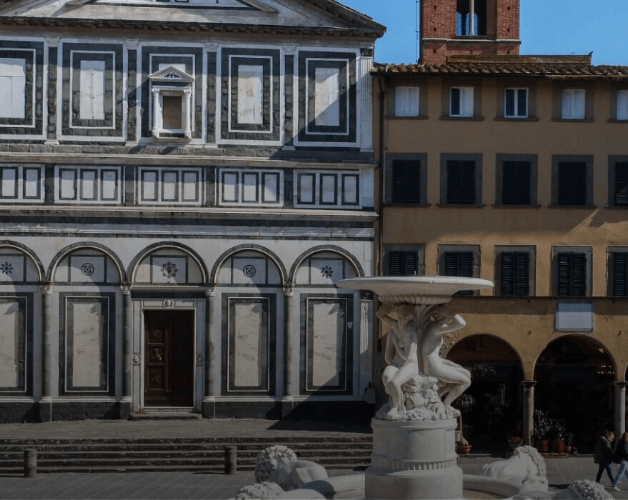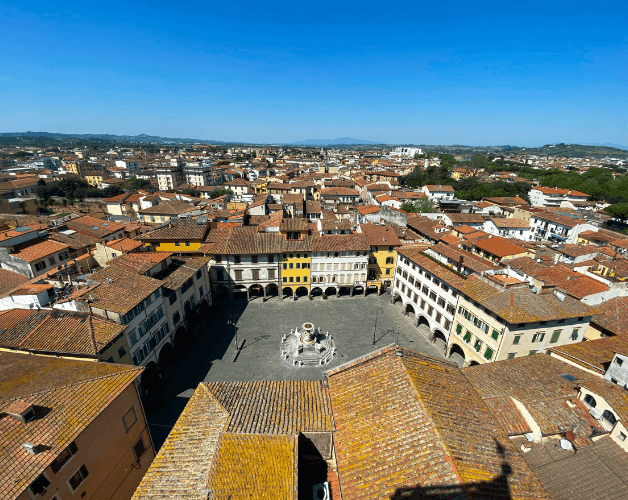Today, as in the past, the Empoli city centre revolves around the set-like Piazza Farinata degli Uberti, which locals usually call Piazza dei Leoni (Square of the Lions).
The reason for this imaginative name is found in the marble fountain that has been in the middle of the square since 1828: the splendid Fontana delle Naiadi, by Luigi Pampaloni and Luigi and Ottavio Giovannozzi. While the group of naiads, mythological freshwater nymphs, is the focal point of the sculpture and impressive for its elegant, delicate rendering, what really captures the eye are the majestic lions that reign over the fountain’s four corners, whence the local nickname for the fountain and, by extension, the whole square.

The most important surviving medieval buildings in Empoli are on Piazza Farinata degli Uberti.
First among them is the Collegiata di Sant’Andrea, the only Florentine Romanesque facade outside Florence. The church was in all likelihood built on the site of an early pagan temple (possibly dedicated to Minerva) and, judging from the inscription on the facade, dates to the end of the 11th century.
Expanded and modified over the centuries, the church as we know it today is aisleless and has five side chapels, one of which preserves a 14th-century cross that is the focus of immense popular devotion.
On the opposite side of the square stands Palazzo Ghibellino, now home to the Museo Paleontologico. The current appearance of the building is the result of 16th-century modifications, but it dates to about 1119, when the Guidi counts began the fortification of Empoli. Later, in 1260, after the Battle of Montaperti, the building was the seat of the Ghibelline Council (whence its name), when Farinata degli Umberti spoke out in defence of Florence, as commemorated by Dante in Canto 10 of the Inferno.
Finally, on the right when looking at the Collegiata, we find Palazzo Pretorio, which became the seat of the municipal authority in the 14th century and is still home to various public offices. This is where the local jails were located and where justice was administered by the podestàs sent by Florence.

Much research has been done to work out the precise location of the four circles of walls that protected Empoli between the 12th and 19th centuries, although there is still no definitive answer. What is certain is that the streets of what is now the city’s historical centre were all inside the walls and their layout has remained much the same over the centuries.
The elegant via Cosimo Ridolfi formerly via degli Asini, during the Middle Ages, was the end part of Via Salaiola, the road along which salt was brought from Volterra to Empoli. In Magazzino del Sale (salt warehouse), which is now the Museo del Vetro (glass museum), the valuable product was stored and preserved to then be sent to the nearby river port on the Arno.
Via del Giglio, which has always been lined with workshops and other businesses, is named after a hotel, the Albergo del Giglio, for which we have documentation dating back to the early 15th century.
Via Giuseppe del Papa, originally via Fiorentina or via Maestra and then Via Ferdinanda, was also a historically business-oriented street, until the 16th century, when it started to become a popular location for the palazzos of nobles and the upper middle class.
If you look carefully amongst the narrow lanes and small squares of the town centre, you might spot a faint trace of the 14th-century walls in Via delle Murina or between Piazza del Popolo and Via Cavour, where the towers of the Righi and Frati families still stand. Some of the masonry of the final wall, built in 1470, can still be seen in Piazza XXIV Luglio, the monumental bastion in the garden of the Torrione di Santa Brigida and the Porta Pisana.
